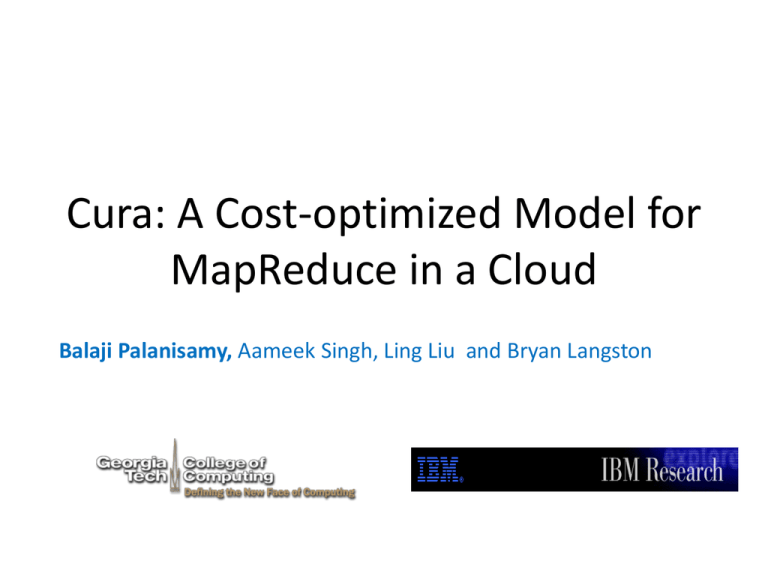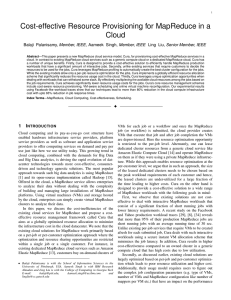Cura - CERCS
advertisement

Cura: A Cost-optimized Model for MapReduce in a Cloud Balaji Palanisamy, Aameek Singh, Ling Liu and Bryan Langston Data Growth Worldwide Corporate Data Growth 40000 35000 IT.com analyses the % of data growth: unstructured data 80 30000 Exabytes 25000 20000 15000 10000 5000 0 2006 2007 2008 2009 Source: IDC, The Digital Universe 2010 2010 2011 2012 2013 2014 2015 2016 2017 2018 2019 2020 Unstructured data Structured data 2 MapReduce in a Cloud • MapReduce and Big Data Processing – Programming model for data-intensive computing on commodity clusters – Pioneered by Google • Processes 20 PB of data per day – Scalability to large data volumes – Scan 100 TB on 1 node @ 50 MB/s = 24 days – Scan on 1000-node cluster = 35 minutes – It is estimated that, by 2015, more than half the world's data will be processed by Hadoop – Hortonworks • MapReduce Applications • At Google, Yahoo, Facebook: – Index building for Google Search, Ad optimization and Spam detection • Bioinformatics/ Biomedical – Large scale DNA Sequence analysis and Biomedical computing 3 MapReduce Execution Overview User Program fork assign map Input Data Split 0 read Split 1 Split 2 fork Master fork assign reduce map map reduce local write reduce map remote read, sort write Output File 0 Output File 1 MapReduce in a Cloud • MapReduce as a Cloud service – an attractive usage model • Enterprises can analyze large amounts of data without creating large infrastructures of their own. • Attractive features: – Elastic Scalability: 100s of nodes available in minutes – Pay per-use – On demand creation of virtual MapReduce clusters of any required size • Existing Dedicated MapReduce Clouds • • Natural extensions of Virtual Machines as a service model Performance and cost-inefficiency 5 Need for Cost-optimized Cloud Usage Model Existing Per-job Optimized Models: Per-job customer-side greedy optimization may not be globally optimal Higher cost for customers Cura Usage Model: User submits job and specifies the required service quality in terms of job response time and is charged only for that service quality Cloud provider manages the resources to ensure each job’s service requirements Other Cloud Managed Resource models: Database as a Service Model Eg: Relational Cloud (CIDR 2011) Cloud managed model for Resource management Cloud managed SQL like query service Delayed query model in Google Big Query execution results in 40% lower cost 6 User Scheduling Vs Cloud Scheduling Job# Arrival time Deadline Running time Optimal no. Of VMs 1 20 40 20 20 2 25 50 20 20 3 30 75 20 20 4 35 85 20 20 User Scheduling Job # 1 2 3 4 Start time 20 25 30 35 Job # 1 2 3 4 Start time 20 25 40 45 80 concurrent VMs Cloud Scheduling 40 concurrent VMs 7 Cura System Architecture 8 Static Virtual Machine sets Pool of Large instances Cluster of physical machines Pool of small instances Pool of extra large instances 9 Static Partitioning of Virtual Machine sets Pool of Large instances Cluster of physical machines Pool of small instances Pool of extra large instances 10 Problem Statements • Resource Provisioning and Scheduling – Optimal scheduling – Optimal Cluster Configuration – Optimal Hadoop Configuration • Virtual Machine Management – Optimal capacity planning – Right set of VMs(VM types) for current workload? – Minimize Capital expenditure and Operational expenses • Resource Pricing – What is the price of each job based on its service quality and job characteristics? 11 VM-aware Job Scheduling Multi-bin backfilling • Scheduler needs to decide on which instance type to use for the jobs • The job scheduler has two major goals: – (i) complete all job execution within the deadlines – (ii) minimize operating expense by minimizing resource usage 12 VM-aware Scheduling Algorithm • Goal: – VM-aware scheduler decides (a) when to schedule each job in the job queue, (b) which VM instance pool to use and (c) how many VMs to use for the jobs. • Minimum reservations without under-utilizing any resources. • Job Ji has higher priority over Job Jj if the cost of scheduling Ji is higher. • For each VM pool picks the highest priority job, Jprior in the job queue and makes a reservation. • Subsequently, the scheduler picks the next highest priority jobs in the job queue by considering priority only with respect to the reservations that are possible within the current reservation time windows of the VM pools. • Runs in O(n2) time • Straight forward to obtain a distributed implementation to scale further Reconfiguration-aware Scheduler When two new jobs need a cluster of 9 small instances and 4 large instances respectively, the scheduler has the following options: 1) Wait for some other clusters of small instances to complete execution 2) Run the job in a cluster available of extra large instances 3) Convert some large or extra large instances into multiple small instances Reconfiguration-unaware Scheduler Reconfiguration-aware Scheduler 14 Number of servers and Effective Utilization Dedicated Cluster Per-job Cluster Cura Dedicated Cluster 10000 No of Servers Cura 600 800 Deadline 1000 0.8 Effective Utilization 12000 Per-job Cluster 8000 6000 4000 2000 0.6 0.4 0.2 0 0 200 400 600 800 Deadline Fig 5. No. of Servers 1000 200 400 Fig 6. Effective Utilization • Cura requires 80% lower resources than conventional cloud models • Cura achieves significantly higher resource utilization 15 Response time and Cost Per-job Cluster Cura Dedicated Cluster 400 2 300 1.5 Cost Response time (sec) Dedicated Cluster 200 0.5 0 0 400 600 800 Deadline Fig 7. Response time 1000 Cura 600 800 Deadline 1000 1 100 200 Per-job Cluster 200 400 Fig 8. Cost • With lower number of servers, Cura provides short response times • Cura incurs much lower infrastructure cost 16 More results in our IPDPS 2013 paper: B. Palanisamy, A. Singh, L. Liu and B. Langston, “Cura: A Cost-optimized Model for MapReduce in a Cloud”, IPDPS 2013 Thank you & Questions




